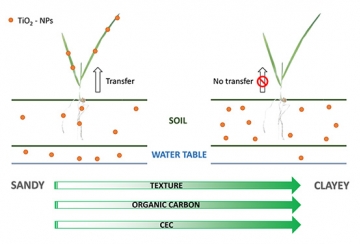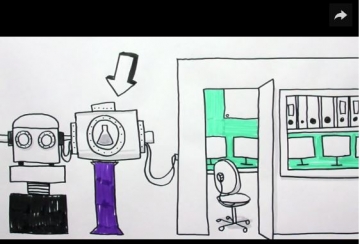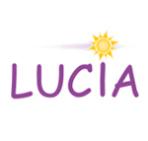
LUCIA is characterized by the production of a microfocused beam in the 0.8-8 keV energy range. The spatial stability of the beam spot over a wide spectral range enables elemental distribution studies by micro-fluorescence X-ray spectroscopy (µ-XRF) as well as elemental speciation by X-ray absorption spectroscopy (XANES and EXAFS) in heterogeneous samples.
The beamline "LUCIA" (Line for Ultimate Characterisation by Imaging and Absorption) is a "tender" (0.8-8 keV) X-ray microprobe with capabilities for chemical speciation by x-ray absorption spectroscopy (µ-XAS) and for elemental mapping by x-ray micro-fluorescence (µ-XRF). It allows the possibility to measure heterogeneous samples at a micronic size and to combine these two element-specific and non-destructive techniques.
A monochromatic beam of µm size is incident on a sample which is carried on a scanning x-z stage. µ XRF shows the location of the elements, their relative abundances, and with which other elements they are associated. One can take advantage of the monochromatic beam which allows to separate out different elements by their absorption edges. After a cartography of the sample by fluorescence, interesting spots can be analyzed by XAS to determine the speciation (local chemistry, quantitative determination of the local geometric structure around the absorbing atom) of the elements and how this depends on the different components.
µ-XRF and µ-XAS can be combined with other microtechniques like Raman spectroscopy to give complementary informations on the sample. The energy range offered by the beamline corresponds to the best performances of SLS and SOLEIL in terms of brilliance. It allows XAS experiments at the K edge of elements from Na to Fe, L edges from Ni to Gd, and M edges of rare earths and actinides.
Team
Technical data
0.6 – 8 keV
Undulator HU52 "Apple II" type, 32 periods, gap 15 – 150mm, variable linear polarization, left and right circular polarizations, operating on harmonics 3 to 21
spherical mirror for horizontal de-magnification; two planar mirrors act as a low pass filter to remove higher harmonics. Their angle of incidence can be varied from 0.4o to 1.3o. All mirrors are silicon coated with nickel.
double crystal monochromator built by Kohzu. Its design is based on a double cam which provides a fixed exit geometry and covers a large angular range (5o- 75o). Up to five different crystals, namely KTP(011), MGM (Multilayer Grating Monochromator), InSb(111), Si(311) and Si(111) fit into the water cooled holders.
A table describing the energy ranges and resolution for each monochromating system can be accessed :
the final focusing is done with a "Kirkpatrick-Baez" (KB) reflecting mirrors system. It is based on an ESRF-design, and was modified to be high vacuum compatible.
theory 1*3 µm2; achieved 2.5*2.5 µm2
8.0*1010 ph/s/400mA @ 4000eV in 2.5*2.5 µm2
1.6*1011 ph/s/400mA @ 4000eV in 1.5*1.5 mm2
Measurements are always performed in a primary vacuum chamber.
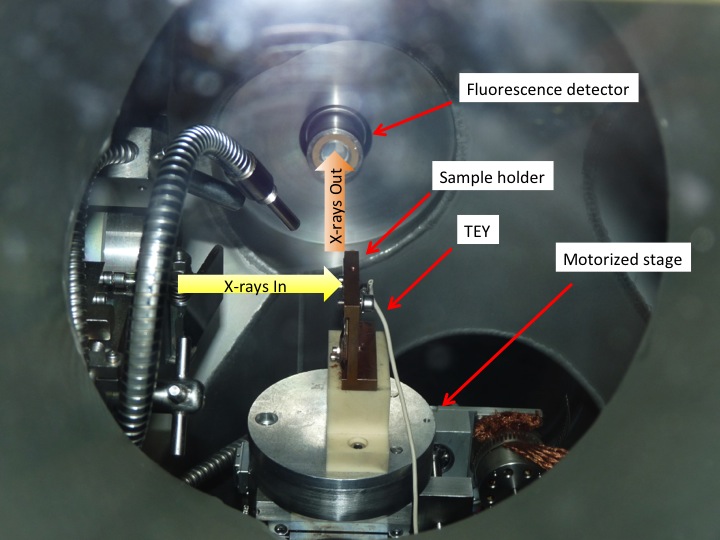
It is rather spacious and can accept a variety of setups, such as the following (click on the pdf links for more details):
- for solid-state samples.
- A motorized (x,y,z)-stage allowing the precise (µm) and reproducible (coders present) positioning of the sample for mapping purposes.
- A liquid / electrochemical .
- An oven
- A He/N2 cryostat
- A peltier
- A Raman head for coupled measurements for coupled measurements :
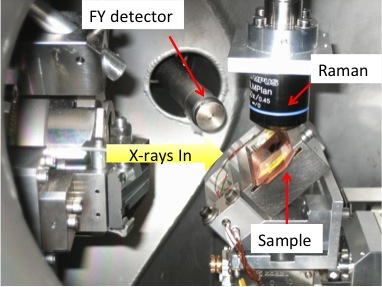
* A Separate UHV chamber for surface science is also available, it is mounted downstream of the main chamber. More information: .
µXRF: measurement of the fluorescence spectra: 4-elements SDD (silicon drift diode) Bruker
µXAS: measurement of the fluorescence yield (FY), of the sample drain current (TEY) and measurement of the transmitted photons flux (diode)
Scientific opportunities
|
Surface Science |
An UHV set-up is currently available on the beamline. It is equipped with a sample preparation chamber (furnace, evaporation cells, ion gun) and a data acquisition chamber allowing a sample characterization with LEED, Auger, XPS and x-ray spectroscopy measurements by total electron yield. In a next future, fluorescence yield will be also installed. Experiments on silicene deposited onto Ag(110) and Ag(111), silver clusters deposited on Al2O3(110), MgO on Ag(100) have already been conducted on the beamline (unpublished results). |
|---|---|
| Material Science |
The characteristics of the LUCIA beamline are perfectly adapted for material sciences. It can take advantage of the µ-focused beam and the adaptable energy range for studying heterogeneous materials. Several equipment are available to probe matter under extreme conditions such as high pressure (diamond anvil cell) or high/low temperatures (ovens and cryostats). Moreover, particular setups can be simultaneously combined in the experimental endstation (Raman – XAS). A wide range of scientific areas can be investigated on LUCIA, from fundamental to applied sciences (technical materials, Earth science, Cultural heritage, Environment,...). |
| Chemistry |
Several equipments can be adapted to the endstation of LUCIA in order to probe chemical reactions in situ. In particular, the study of liquids, as well as solid-liquid interfaces is possible. Liquid, electrochemical or catalysis cells are being developped and can be designed for specific needs. Scientific areas explored at LUCIA with these sample environments range from supported catalysis and thin film electrochemistry to elemental speciation in oil residues or nanoparticle synthesis routes. |
| Life Science |
LUCIA can take advantage of its microfocused beam and is energy range for the study of biological samples. The micron-sized beam can be used for mapping macroscopic samples such as cells or tissues. The regions of interests can then be further analyzed by classical X-ray absorption techniques. The tender X-ray energy range of LUCIA can be used to study specific elements of metalloproteins or related model compounds. Light elements such as sulfur, phosphorus, or chlorine can be studied in model complexes, while alkaline or transition metal ions can be probed in proteins themselves. |
Beamline scheme
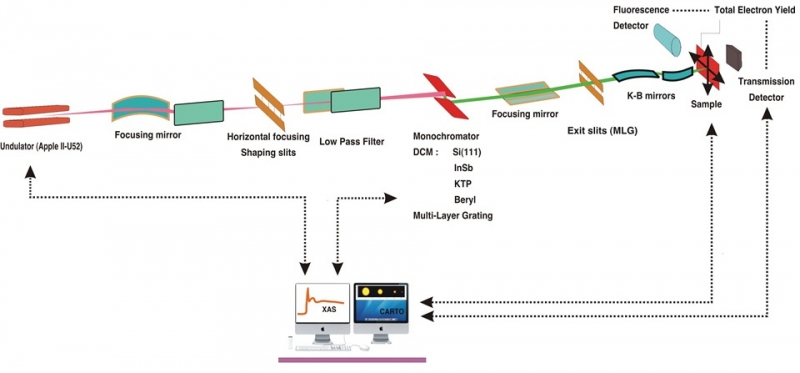
User guide
You can download the user guide of LUCIA here. It contains all the information to perform simple operations at LUCIA. Feel free to use it as much as you want, but don't think it allows you to play with any parameter on the beamline...
Proposal submission
Proposal submissions are done through the SUNSET, le portail des utilisateurs de SOLEIL.
The submission dates are the same every year: Februay 15 and Septembre 15.
It is strongly recommented to contact one of the beamline scientist (see Team) before submitting a proposal to the PRCs.
Links
The x-ray data booklet for X-rays and other photons users edited by the Center for X-ray Optics and theAdvanced Light Source.
User information: publications
Publication technique générale sur LUCIA:
 LUCIA, a microfocus soft XAS beamline (511.97 KB)
LUCIA, a microfocus soft XAS beamline (511.97 KB)
Publication sur l'outil de visualisation du micro-faisceau de LUCIA:
Publications sur le couplage µRaman - µXRF sur LUCIA:
 Combining two structural techniques on the micrometer scale: µXAS and µRaman spectroscopy (868.04 KB)
Combining two structural techniques on the micrometer scale: µXAS and µRaman spectroscopy (868.04 KB) Applications in materials science of combining Raman and X-rays at the macro and micrometric scale (1.38 MB)
Applications in materials science of combining Raman and X-rays at the macro and micrometric scale (1.38 MB)
Publications d'utilisateurs représentatives des possibilités offertes par LUCIA:
 Local structures around Na, K, Ca, Mn, Fe and Cu in medieval glasses: effect of weathering (92.45 KB)
Local structures around Na, K, Ca, Mn, Fe and Cu in medieval glasses: effect of weathering (92.45 KB) High pressure x-ray absorption at low energy (31.85 KB)
High pressure x-ray absorption at low energy (31.85 KB) Investigation on corrosion of ion archaelogical artefacts using microfocused synchrotron X ray absorption spectroscopy and imaging (146.67 KB)
Investigation on corrosion of ion archaelogical artefacts using microfocused synchrotron X ray absorption spectroscopy and imaging (146.67 KB) Microscale distribution and speciation of Pb and Sb in shooting range soils (107.16 KB)
Microscale distribution and speciation of Pb and Sb in shooting range soils (107.16 KB)


